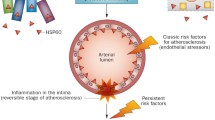Summary.
Recent studies provide evidence that infectious agents play a causal role in the pathogenesis of atherosclerosis. In this respect, a chronic persistent Chlamydia pneumoniae infection, indicated by the presence of chlamydial heat shock protein 60 (cHSP 60), is of central interest. Both cHSP60 and endogeneous human (h) HSP60 are upregulated under stress conditions in intimal cells and serve as a target for cross-reactive cytotoxic HSP-serum-antibodies. Therefore, the present study evaluates the expressions of both HSP60 homologues in advanced human coronary lesions and a correlation between intimal tissuebound protein and serum antibodies (Ab) to HSP65.
Coronary atherectomy specimens retrieved from 114 primary target lesions of patients with acute coronary syndrome (ACS; n=46) or stable angina (SA; n=68) were assessed immunohistochemically for the presence of cHSP60 and hHSP60. Chronic persistency of Chlamydia pneumoniae was additionally examined by transmission electron microscopy. Blood samples from30 patients were tested for anti-Chlamydia pneumoniae-IgG/IgA- and anti-HSP65-Ab titers and for serum CRP levels.
Coronary plaques revealed immunoreactive cHSP60 in 47% and hHSP60 in 57% of the lesions colocalized within macrophages/foam cells. Chlamydia in foam cells most often presented ultrastructural patterns that pointed to the persistency of the pathogen. Intact, non-atherosclerotic vessels showed no signals. Mean expressions were 3.1% for cHSP60 and 3.3% for hHSP60. As a central finding, the expression of both HSP homologues was significantly (each p<0.001) higher in ACS lesions compared to SA lesions (cHSP60: 6.2 vs 1.0%, and hHSP60: 7.2 vs 0.7%). Moreover, we found positive correlations between both determinants in ACS and SA lesions (r=0.41, r=0.37; p<0.01). Most interestingly, cHSP60 revealed no relationship with anti-Chlamydia pneumoniae-IgG/IgA titers, whereas expression of cHSP60 as well as that of hHSP60 correlated with anti-HSP65-Ab titers (r=0.50, p<0.01, and r=0.42, p<0.05, respectively).
cHSP60 and hHSP60 colocalize within coronary primary atheroma, most prevalent in lesions associated with ACS. For the first time, our data demonstrate a significant correlation between the intimal expression of these HSP60 homologues and serum HSP65 antibodies, thereby suggesting that humoral immune reactions to bacterial and human HSPs may play an important role in coronary atherosclerosis and plaque instability.
Zusammenfassung.
Infektiöse Pathogene werden als kausale Faktoren in der Arteriosklerosepathogenese diskutiert. Dabei könnte chronisch-persistierenden Chlamydia pneumoniae-Infektionen, angezeigt durch chlamydiales (c) Hitzeschockprotein 60 (HSP60), eine wesentliche Rolle zukommen. Postuliert werden Kreuzreaktionen spezifischer Serumantikörper, gerichtet gegen cHSP60 und humanes (h) HSP60, mit zytotoxischer Wirkung auf intimale Zellen. Diese Studie untersucht die Expressionen beider HSP60-Homologe in koronarem Plaquegewebe und evaluiert eine mögliche Korrelation zwischen gewebeständiger intimaler Expression und dem HSP65-Serumantikörper-Titer.
Analysiert wurde Atherektomiegewebe von 46 Patienten mit akutem Koronarsyndrom (ACS) entsprechend der Braunwald-Klassifizierung und von 68 Patienten mit stabiler Angina (SA). Der Nachweis der HSPs erfolgte immunhistochemisch mittels APAAP-Methode. Chronische Erregerpersistenz wurde zusätzlich ultrastrukturell evaluiert. Bei 30 Patienten erfolgte die Serumbestimmung der Antikörper (AK) gegen mykobakterielles (m) HSP65 sowie von Anti-Chlamydia pneumoniae-IgG/IgA und dem Serum-CRP-Spiegel.
Koronare Plaques zeigten immunreaktives cHSP60 in 47% und hHSP60 in 57% der Läsionen, überwiegend in Makrophagen und Schaumzellen kolokalisiert. Chlamydien in Schaumzellen waren charakterisiert durch ultrastrukturelle Muster, die auf Erregerpersistenz hinweisen. Gesundes Kontrollgewebe war ohne Nachweis. Die mittleren Expressionen lagen bei 3,1% für cHSP60 und 3,3% für hHSP60. Allerdings zeigte sich eine signifikant höhere intimale Expression beider HSP60-Homologe bei ACS gegenüber SA (cHSP60: 6,2% vs. 1,0%, hHSP60: 7,2% vs. 0,7%; p<0,001). Darüber hinaus fanden sich positive Korrelationen der HSP-Homologe in beiden Untergruppen (r=0,41, r=0,37; p<0,01). Intimale cHSP60-Expresssion zeigte keine Zusammenhänge mit der Chlamydienserologie, korrelierte aber als Schlüsselbefund – wie das humane Homolog – positiv mit dem AntimHSP65-AK-Titer (cHSP60: r=0,50; p<0,01; hHSP60: r=0,42; p<0,05).
Chlamydiales und humanes HSP60 sind in einem hohen Prozentsatz koronarer Atherome mit einer Prävalenz bei ACS nachweisbar. Unsere Studie demonstriert erstmals eine positive Korrelation zwischen der intimalen Expression beider Determinanten und dem mHSP65-AK-Titer im Serum. Diese Befunde legen einen wesentlichen Stellenwert humoral vermittelter Immunreaktionen gegen bakterielles und körpereigenes HSP60 bei koronarer Arteriosklerose und Plaqueruptur nahe.
Similar content being viewed by others
Author information
Authors and Affiliations
Additional information
Eingegangen: 20. November 2002, Akzeptiert: 10. Februar 2003
Correspondence to: Prof. Dr. Gerhard Bauriedel
Rights and permissions
About this article
Cite this article
Andrié, R., Braun, P., Welsch, U. et al. Chlamydiales und humanes Hitzeschockprotein 60 bei akutem Koronarsyndrom . Z Kardiol 92, 455–465 (2003). https://doi.org/10.1007/s00392-003-0933-4
Issue Date:
DOI: https://doi.org/10.1007/s00392-003-0933-4




